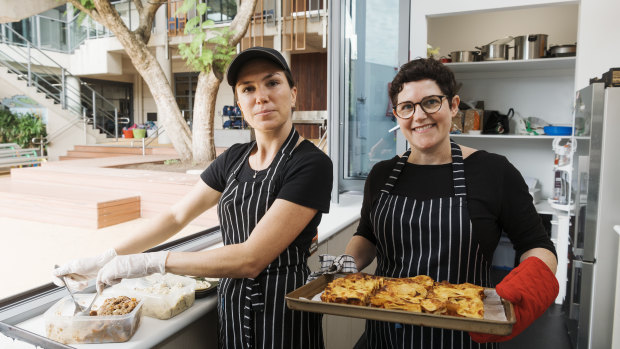By Jordan Baker and Nigel Gladstone
This year, Dan Wilson added roasted chickpeas and fava beans to the snack menu at his network of North Shore primary school canteens. These healthy options have not proved popular with his pint-sized customers, who prefer to buy sweets at the petrol station after school.
Since Mr Wilson complied with the new healthy canteen guidelines, which require "everyday foods" to make up 75 per cent of the menu, his revenue has dropped by 20 per cent. "If it doesn't turn out to be viable, I am probably not going to continue doing it," he said.

Karin Von Specht, right, and Nina Wilson serve healthy food at the St Mary's Primary School Canteen in North Sydney. Credit: James Brickwood
He would not be alone. The industry expects higher costs and lower sales will cause many small operators to leave the business after the new guidelines become compulsory next year, forcing some schools to close their canteens.
Since the 2017 launch, only a quarter of the state's 1800 canteens have been accredited. The deadline for mandatory compliance across the public system is December, but insiders privately believe many of canteens will not meet it.
Under the revised strategy, 'occasional' items (sausage rolls, muffins) are to be reduced to 25 per cent of the menu, and replaced by 'everyday' food (homemade meals, fruit, lean meat sandwiches).
The guidelines are optional for Catholic and independent schools.
There are strict portion limits, pre-packaged food must have a 3.5 health star rating, and only everyday food can be promoted. So-called 'red' days – when canteens could serve junk food – are no longer allowed.
Canteen licence-holders acknowledge the health benefits of the new rules but are concerned that the higher costs, customer reluctance and ready availability of alternatives such as Uber Eats will hurt business.
Graham Bernard from Healthy Canteens Australia has had the menu for his 80 NSW canteens accredited under the new rules.
To meet the standards, he now makes most food from scratch. That requires extra staff, which costs more money. He is also buying more expensive packaging to make the food look appealing, and increasing his spend on fresh produce.
Once canteens could order food from wholesalers, but portion and sodium limits now make that difficult. A few manufacturers have developed school canteen-specific product lines, but they are more costly.
Mr Bernard's company is big enough to devise economies of scale, and rely on volume rather than margins, but he says others – especially those only open a day or two a week – cannot do the same. "Definitely some schools won't have a canteen [from next year], that's 100 per cent sure," said Mr Bernard.
"I've had at least 20 P&Cs, or people running them, contact us this year asking for help and advice. There's no way even I could personally run one canteen, make the food, buy it, make up the recipes and quantities and portion control."
In high schools, there's another problem. Some students bypass the canteen altogether and order takeaway. "Kids order Uber Eats. Kids have Pizza Hut delivered.
It happens daily," said Mr Bernard.
The Healthy Kids Association is helping schools comply with the new guidelines. Chief executive David Pratt admitted that "change is a difficult process", and said some operators had complained about the cost burden.
"But again we have also had feedback where canteen managers said they are making even more money than before," he said. "We have some feedback that ... students are trying new foods. What we are seeing so far is promising. There is a lot of effort going into getting everyone over the line by the end of the year."
Mr Pratt admitted there was nothing to stop students buying only occasional foods under the new regime. "Education is the only way around that," he said. "The goal here is to improve the long term health of the population."
A spokesman for the NSW Department of Education said the canteen strategy allowed for schools that struggled to buy fresh produce or make food from scratch. They could use frozen vegetables, canned fruit or commercial food that met the criteria.
Canteens were given help to make the transition. "This includes increasing manager’s skills in balancing a healthier menu within a sustainable business model." He said a health report card from Deakin University said NSW was taking more action than any other state to improve food in schools and hospitals.
Mr Wilson will keep trying to make his canteens work. He will reduce the focus on snack food, and introduce winter meals he hopes will be a hit, such as spaghetti and meatballs. He has invested in six slushy machines for watermelon slushies.
"I'm hoping [the new menu] will have a trickle-down effect on sales," Mr Wilson said. He is considering asking the NSW Department of Education for a rent reduction. "We are trying to do as much as we can."
Continue the conversation at our SMH Student Facebook group.